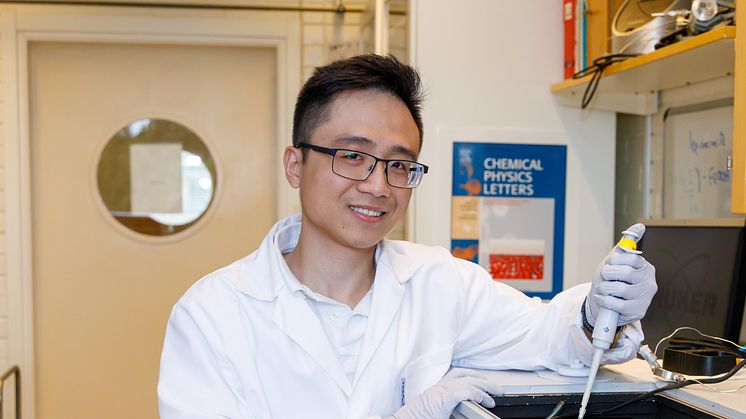
Press release -
Water films – the silent architects of chemical transformations
Air moisture landing on surfaces of materials forms thin, invisible, water films. These films play crucial roles in Earth’s soils and atmosphere as well as in new technologies. A thesis at Umeå University sheds new light on how this silent architect mediates chemical reactions.
Water films are virtually present on all minerals exposed to air moisture, from dry soils to atmospheric dust. The number of water layers that minerals can store is directly controlled by atmospheric humidity. Tan Luong’s thesis unveils how water films of various thicknesses impact two important phenomena for nature and technology: the transformation of minerals, and the breakdown of organics. His discoveries contribute to new fundamental science urgently needed to tackle some of humanity’s top challenges, such as global warming and pollution control.
New minerals can grow from ions – charged atoms or molecules – that dissolve from primary minerals into water films. These ions react further with environmental gases, such as carbon dioxide and oxygen, and grow into new minerals that can alter the function of the primary mineral.
Extremely thin water films partially covering mineral surfaces can still host mineral growth, yet only in two dimensions, akin to growing a single sheet of paper laterally. In contrast, thicker water films with more than one layer, stimulate three-dimensional growth, just like stacking many sheets of papers into a book.
“This knowledge is beneficial for fabricating materials in environments with controlled humidity. Size and shape of materials impact their functions in advanced technologies, including battery development and pollutant removal strategies,” says Tan Luong.
Many carbon dioxide (CO2) capturing technologies are challenged by energetic costs that can, in turn, leave a carbon footprint. As such, an eco-friendly solution mimicking how natural rocks, such stalagmites in caves, capture CO2 might help achieve zero emission.
To this end, Tan Luong studied the CO2-capturing capability of magnesia (MgO), a building block of targeted mine wastes that is a potential material for developing greener technologies. He however found that the ultrathin magnesium carbonate product coatings can effectively poison the reactions. He then identified a promising pathway that can bypass this bottleneck by chemical attack under extremely high humidity.
“We highlighted the potential of MgO for capturing CO2 under dynamic humidity conditions. Still, to achieve eco-friendly and efficient capturing, more work is needed to avoid the coatings that hinder the reactions,” says Tan Luong.
Tan Luong’s study also revealed how oxygen and water films speed up or slow down the conversion of organic pollutants into harmless substances – such as CO2 and water – by an approach that turns light energy into chemical energy. His findings then advance our fundamental knowledge that is necessary for innovations in water and air purification technologies.
About the thesis
Tan Luong, Department of Chemistry, Umeå University, defended his thesis entitled Water film-mediated mineralogical transformations and photocatalytic reactions on Friday 29 September. The faculty opponent was Dr. Alejandro Fernandez-Martinez, Université Grenoble Alpes, France.
For more information, please contact:
Tan Luong, Department of Chemistry, Umeå University
Phone: +46 76 589 5462
Email: tan.luong@umu.se
Topics
Categories
Umeå University
Umeå University is one of Sweden’s largest institutions of higher education with over 37,000 students and 4,300 faculty and staff. The university is home to a wide range of high-quality education programmes and world-class research in a number of fields. Umeå University was also where the revolutionary gene-editing tool CRISPR-Cas9 was discovered that has been awarded the Nobel Prize in Chemistry.
At Umeå University, distances are short. The university's unified campus encourages academic meetings, an exchange of ideas and interdisciplinary co-operation, and promotes a dynamic and open culture in which students and staff rejoice in the success of others.


